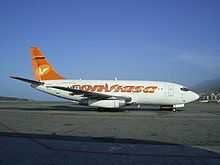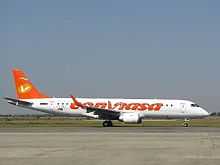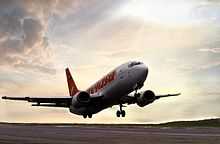Conviasa
|
| ||||
| ||||
| Founded | 31 March 2004 | |||
|---|---|---|---|---|
| Hubs | Simón Bolívar International Airport | |||
| Focus cities | Santiago Mariño International Airport | |||
| Frequent-flyer program | Infinito | |||
| Fleet size | 23 (+11 Orders,14 Options) | |||
| Destinations | 22 + 10 | |||
| Company slogan |
El placer de volar (the pleasure of flying) | |||
| Parent company | Ministry of Aquatic and Air Transport | |||
| Headquarters |
Simón Bolívar International Airport Maiquetía, Venezuela | |||
| Key people |
Hebert García Plaza, Minister of water and air transport Luis Gustavo Graterol Caraballo, CEO Conviasa Eduardo Legaspi, Vice-President Conviasa | |||
| Website | conviasa.aero | |||
Conviasa (Consorcio Venezolano de Industrias Aeronáuticas y Servicios Aéreos, S.A.) is an airline with its headquarters on the grounds of Simón Bolívar International Airport in Maiquetía, Venezuela, near Caracas.[1] It is the flag carrier and largest airline of Venezuela, operating services to domestic destinations and to destinations in the Caribbean and South America. It plans to add destinations in Europe to its network. Conviasa is under the authority of the Ministry of Aquatic and Air Transport.[2] On 3 April 2012, the European Union banned Conviasa flights from its airspace, but removed on 10 July 2013.[3]
History
In January 1997, Venezuela's former flag carrier, Viasa, ceased operations after 37 years of service due to prolonged financial problems. In May 2001, the idea to create a new flag carrier for Venezuela was proposed, but in December 2002, the project was put on hold until 1 October 2003. On 30 March 2004, the President of Venezuela, Hugo Chávez, signed a decree that formally established the airline. This decree was published in the nation's official gazette the next day.
On 28 November 2004, Conviasa's inaugural flight was made with a De Havilland Canada Dash 7 aircraft flying from the airport in Charallave to the Santiago Mariño International Airport, on Margarita Island. On 10 December 2004, Conviasa formally began its national and international operations. Conviasa was originally run by the now defunct Ministry of Production and Commerce (Ministerio de la Producción y el Comercio), but it has since been taken over by the Ministry of Infrastructure.[4]
On 17 April 2006, José David Cabello Rondon replaced Wilmer Castro Sotelo as head of Conviasa. On 30 June 2006, Jose David Cabello Rondon replaced Ramon Alonzo Carrizalez Rengifo as the Minister of Infrastructure and on 18 July 2006, Franklin Fernandez Martinez became president of Conviasa.
The airline is owned by the Venezuelan government (80%) and the regional government of Nueva Esparta (20%).
Following the Flight 2350 crash, on September 17, 2010, the government of Venezuela grounded all Conviasa flights so that it could perform a technical review of the airline's fleet. The airline said that the temporary suspension would remain in effect until October 1, 2010. Flights have since been re-instated.
Decree No. 7838 of the Official Gazette No. 39,558 published on Wednesday, provides for the appointment of Colonel citizen (AVB) Jesús Rafael Viñas García, President of the Venezuelan Consortium Trading Company Aircraft Industries and Air Services SA (CONVIASA) under the Ministry of Popular Power for Transportation and Communications.
On April 2012, Conviasa has been banned from flying to countries in the European Union because of safety concerns. It said that Conviasa failed to show it had taken adequate steps to prevent future accidents.[5]
Conviasa was under the authority of the Ministry of Transport and Communications.[6]
Destinations
Conviasa operates the following services (as of 9 December 2013):


- Argentina
- Buenos Aires - Ezeiza Airport
- Colombia
- Bogota - El Dorado International Airport
- Cuba
- Dominica
- Grenada
- Nicaragua
- Panama
- Spain
- Madrid - Barajas Airport (operated by Orbest Orizonia Airlines)
- Trinidad and Tobago
- Venezuela
- Barcelona - Generál José Antonio Anzoátegui International Airport
- Barinas - Barinas Airport
- Cabimas - Oro Negro Airport
- Caracas - Simón Bolívar International Airport Hub
- Coro - José Leonardo Chirinos Airport
- El Vigía, Mérida - Juan Pablo Pérez Alfonso Airport
- La Fria - La Fria Airport
- Las Piedras - Josefa Camejo International Airport
- Maracaibo - La Chinita International Airport
- Maturín - Maturín Airport
- Porlamar - Del Caribe International General Santiago Marino Airport
- Puerto Ayacucho - Cacique Aramare Airport
- Puerto Ordaz - Manuel Carlos Piar Guayana Airport
- Santo Domingo - Mayor Buenaventura Vivas Airport
- Valera - Dr. Antonio Nicolás Briceno Airport
Terminated
- Iran - Tehran
- Ecuador - Guayaquil/Quito
- Syria -Damascus
Next possible destinations
Guyana - Cheddi Jagan International Airport
Domestic
- Venezuela
- Cumana - Antonio Jose de Sucre International Airport
- Merida - Alberto Carnevalli Airport
- Puerto Cabello - Bartolomé Salom Airport
- San Fernando de Apure - Las Flecheras Airport
- Santa Elena de Uairen - Aeropuerto de Santa Elena de Uairen
International
- Bolivia
- Brazil
- Manaus - Eduardo Gomes International Airport
- São Paulo - São Paulo-Guarulhos International Airport
- Mexico
- Mexico City - Mexico City International Airport
- Peru
- United States of America
- Suriname
Fleet
The Conviasa fleet[7][8][9][10][11] includes the following aircraft:

| Aircraft | In Fleet | Orders/Options | Passengers | Notes |
|---|---|---|---|---|
| Airbus A340-200 | 1 | 0/0 | 286 | Named "Simón Bolívar El Libertador". |
| ATR 42-400 | 2 | 0/0 | 46 | |
| ATR 72-200 | 6 | 0/0 | 70 | |
| Boeing 737-200 | 2 | 0/0 | 108 | |
| Boeing 737-300 | 6 | 0/0 | 130 | |
| Bombardier CRJ700ER | 4 | 4/0 | 72 | |
| Embraer 190 | 13 | 7/14 | 104 | The first three aircraft arrived in 2012, the others three aircraft arrived on July 1, 2013[12] |
| Total | 34 | 11/14 |
Conviasa received their Airbus A340-200 on 11 May 2006 for its Madrid route from Air Europa, but the plane remained unused; then it operated Damascus and Buenos Aires flights.
The average age of Conviasa's fleet is 19.8 years.[13][14]
Incidents and accidents
- On 15 December 2005, Conviasa flight 2600, a De Havilland Canada Dash 7 with 36 passengers and 4 crew members on board, was forced to make a belly landing at Porlamar's airport when the landing gear failed to deploy. After circling Porlamar for an hour and a half to burn off fuel, the aircraft touched down without any injuries.[15][16]
- On 30 August 2008, a Boeing 737-200 took off from Caracas's Maiquetia airport, Venezuela, and was bound to Latacunga, Ecuador, 80 kilometers (50 miles) south of Quito. Three crew members (a captain, a first officer and a mechanic) were on board. The plane crashed in mountainous area in Ecuador’s Andes, killing all the three people on board. The Boeing 737 had been stored for a while at Caracas. It was being ferried to Latacunga, reportedly underway to a new owner.
- On 13 September 2010, Flight 2350, an ATR 42-300 (registration YV1010), with 47 passengers and 4 crew on board, crashed shortly before landing. It was a domestic scheduled passenger flight from Del Caribe "Santiago Mariño" International Airport, Porlamar, Isla Margarita to Manuel Carlos Piar Guayana Airport, Ciudad Guayana.[17][18] There were 34 survivors and 17 fatalities.[19]
Headquarters
Conviasa has its headquarters on the grounds of Simón Bolívar International Airport in Maiquetía, Venezuela, near Caracas.[20][21]
Originally Conviasa had its headquarters on Margarita Island.[22] At one time Conviasa had its headquarters in the East Tower of Parque Central in Caracas.[23]
References
- ↑ "Directory: World Airlines". Flight International. 3 April 2007. p. 68.
- ↑ "Organigrama." (Archive) Ministry of Aquatic and Air Transport. Retrieved on April 17, 2012.
- ↑ "EU Removes Philippine Air, Conviasa From Access Blacklist" Bloomberg, 10 July 2013
- ↑
- ↑ Neuman, William (4 April 2012). "Venezuela: Airline Banned by Europe". The New York Times.
- ↑ "Organismos." Ministry of Transport and Communications. Retrieved on May 6, 2011.
- ↑ ConViasa Official Fleet page
- ↑ "Conviasa". ch-aviation.ch. Retrieved 2013-08-31.
- ↑ Planespotters.net page for Conviasa
- ↑ Luzair official page
- ↑ OAG Fleet iNet
- ↑ "Venezuela’s Conviasa Orders Six Embraer 190s and Options 14". Airlinesanddestinations.com. 2012-07-31. Retrieved 2013-08-31.
- ↑ "Fleet age ConViasa | Airfleets aviation". Airfleets.net. Retrieved 2013-08-31.
- ↑ "Conviasa Fleet Details and History - Planespotters.net Just Aviation". Planespotters.net. Retrieved 2013-08-31.
- ↑ "Avión de Conviasa aterrizó de emergencia en aeropuerto de Margarita". Primera-clase.com. Retrieved 2013-08-31.
- ↑ "ATERRIZAJE DE EMERGENCIA DEL YV-1003 EN MARGARITA, VENEZUELA". Rescate.com. Retrieved 2013-08-31.
- ↑ "Plane crashes in eastern Venezuela". BBC News Online. 14 September 2010. Retrieved 13 September 2010.
- ↑ "Crash: Conviasa AT42 near Puerto Ordaz on Sep 13th 2010, impacted terrain". Aviation Herald. 2010-09-13. Retrieved 2010-09-13.
- ↑ "Aumentan a 17 fallecidos por accidente de avión de Conviasa - El Universal Venezuela." (in Spanish). Retrieved 14 September 2010.
- ↑ "Contacts." Conviasa. Retrieved on May 9, 2010.
- ↑ "Sede Principal." Conviasa. Retrieved on May 9, 2010. "Av. Intercomunal Aeropuerto Internacional de Maiquetía Edf. Sector 6.3, Zona Estratégica, Lado Este del Aeropuerto Internacional de Maiquetía, Adyacente a Tránsito Terrestre. Venezuela."
- ↑ Bloomberg News and Wire Reports. "GLOBAL BUSINESS." South Florida Sun. March 12, 2004. 3D. Retrieved on May 9, 2010. "Conviasa which will have headquarters on the tourist island of Margarita."
- ↑ "Contactos." Conviasa. July 11, 2007. Retrieved on May 9, 2010. "Dirección Sede Principal Av. Lecuna, Parque Central, Torre Oeste, Piso 49, Caracas, Venezuela."
External links
| Wikimedia Commons has media related to Conviasa. |
- (Spanish) Conviasa
- (Spanish) Part one of the decree that created Conviasa
- (Spanish) Part two of the decree that created Conviasa
- (English) Conviasa (Archive)
- (English) Conviasa (Archive 2)
| ||||||||||||||
| |||||||